About Author
Bridget Mathis brings over a decade of expertise as an occupational therapist, with a focus on stroke rehabilitation, geriatrics, and education. Holding a master’s degree in occupational therapy from Bay Path University and licenses to practice in Florida, Texas, and Virginia, she is deeply knowledgeable about patient care. Bridget is passionate about integrating technology into therapy to enhance patient outcomes and engagement.
Key Takeaways
· Observation is Key: Keen observation of patients is vital for occupational therapists to understand their challenges and tailor treatment plans effectively.
· Beyond the Metrics: While standardized assessments and technology provide valuable data, therapists’ clinical observations are equally crucial for interpreting patient outcomes and identifying underlying issues.
· Technology Enhances, Not Replaces: Tools like driving simulators can provide quantitative data, but therapists’ observations remain indispensable for a holistic understanding of patient progress.
The Power of Observation in Therapy
From the earliest days of training, occupational therapists learn the importance of “sitting on their hands” and observing patients before intervening. This practice goes beyond simply watching – it’s about actively analyzing how patients interact with tasks, their environment, and the therapist themselves. By understanding these dynamics, therapists can break down tasks, identify specific challenges, and develop targeted interventions. For example, a therapist might observe that a patient struggles with buttoning their shirt, not because of motor impairment but due to cognitive difficulties in sequencing the steps involved. Such insights lead to more effective and personalized treatment plans.
Observation in Action: Building a Foundation for Success
Observations begin from the first interaction with a patient. Therapists listen and watch attentively, assessing not only physical abilities but also emotional state, communication, and comprehension. These insights are essential for creating a safe and supportive therapeutic environment. A patient’s body language, tone of voice, and facial expressions can reveal anxiety, frustration, or even hidden strengths that might not be apparent through formal assessments. By attuning themselves to these subtle cues, therapists foster trust, build rapport, and create a collaborative atmosphere that facilitates healing and growth.
Combining Observations and Technology: A Winning Formula
Technology plays an increasingly important role in rehabilitation, providing tools for assessment and intervention. While these tools generate valuable data, therapists’ observations remain critical for interpreting results and uncovering underlying causes of challenges. For instance, a virtual reality system might measure a patient’s range of motion during a simulated activity, but it’s the therapist’s trained eye that notices compensatory movements or signs of fatigue that might impact real-world performance. This integration of objective data and subjective observations creates a comprehensive picture of the patient’s abilities and limitations.
Driving Success: The STISIM Drive Example
Consider the use of a driving simulator. While the metrics report may reveal collisions, the therapist’s observations during the simulation offer a richer understanding. Is the patient struggling with physical limitations, delayed processing speed, or impaired judgment? Do they recognize the implications of their actions? These insights inform a more comprehensive treatment plan. Perhaps a patient’s collisions stem not from poor reaction time but from difficulty scanning their surroundings effectively. The therapist can then incorporate visual attention exercises into their treatment, targeting the root cause of the driving challenge.
The Therapist’s Expertise: An Essential Ingredient
Both clinical observations and standardized assessments are vital components of effective therapy. Technology enhances, but does not replace, the therapist’s expertise. Tools like the STISIM Drive enable therapists to observe and obtain data simultaneously, providing a comprehensive picture of patient progress. It’s the therapist’s clinical reasoning, honed through years of education and experience, that allows them to synthesize this information and develop a treatment plan that’s both evidence-based and tailored to the individual’s unique needs and goals.
Conclusion: Embrace the Power of Observation
The art of observation is at the heart of occupational therapy. By combining keen observations with data and technology, therapists can unlock the full potential of their patients and guide them towards success. The human connection forged through attentive observation fosters trust, empowers patients, and ultimately leads to more meaningful and impactful outcomes.
Looking to improve patient engagement and outcomes?
Schedule a consultation today to explore personalized strategies that leverage observation and technology in therapy: https://stisimdrive.com/contact/
